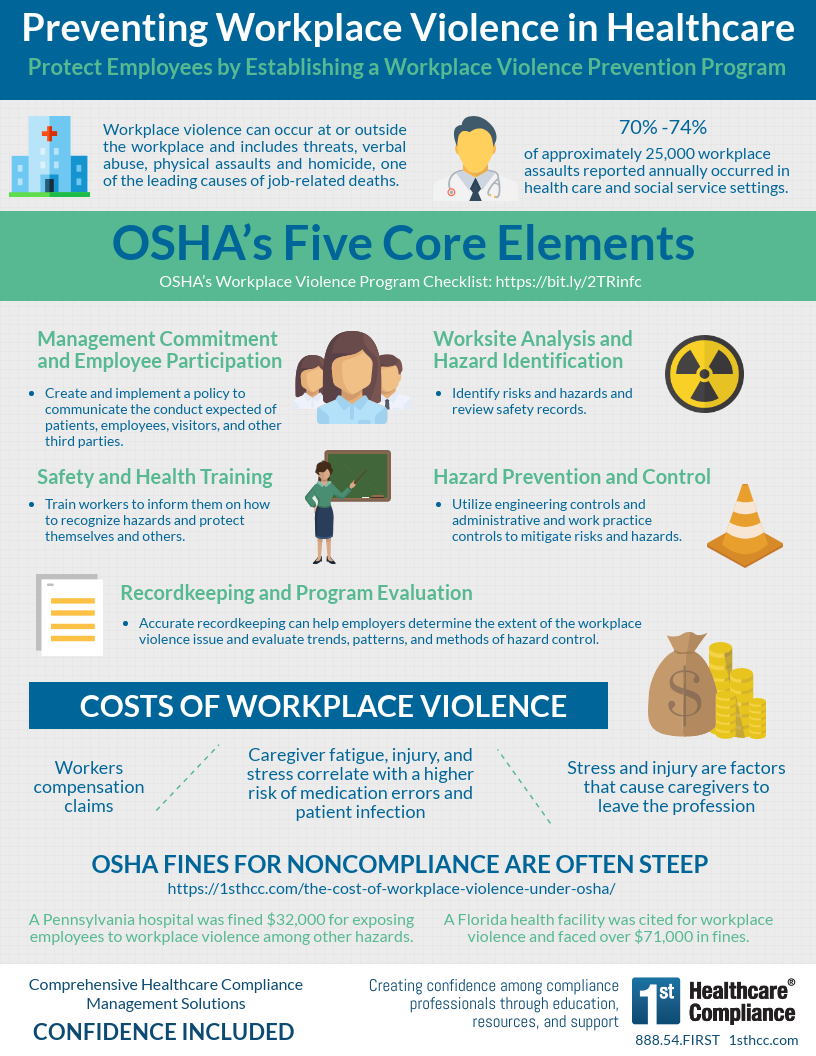Key Components of Effective California Workplace Violence Prevention Programs
Key Components of Effective California Workplace Violence Prevention Programs
Blog Article
Proven Strategies for Producing a Safe and Safeguard Office Setting Via Violence Prevention Actions
In the world of workplace security, the relevance of carrying out efficient physical violence prevention measures can not be overstated. As organizations make every effort to cultivate settings that are not only efficient yet additionally risk-free for all staff members, the demand for tested strategies in violence avoidance becomes critical. By discovering techniques such as conflict resolution training, emergency reaction preparation, and promoting a society of safety, workplaces can considerably improve their capability to mitigate possible dangers. These strategies not only deal with the instant issues surrounding office physical violence however also add to long-term approaches for creating a safe and secure and harmonious work atmosphere.

Understanding Work Environment Physical Violence
To understand the characteristics of workplace violence, it is vital to assess the numerous types and underlying variables adding to such incidents. Workplace violence can manifest in various methods, consisting of spoken threats, physical attacks, and also fatalities. Comprehending the types this physical violence can take is vital in creating effective avoidance techniques.
One typical kind of workplace physical violence is physical hostility, which entails any physical contact intended to create harm. This can vary from pushing and hitting to more extreme activities. Verbal threats and harassment also constitute office violence, creating an aggressive environment that can impact employees' wellness and performance.
In addition, work environment physical violence can be fueled by different underlying aspects such as stress, conflicts, and business modifications. Identifying these source enables organizations to execute preventative actions that resolve the specific risks present in their workplace.
Implementing Conflict Resolution Training
Comprehending the types and underlying variables of office physical violence emphasizes the necessity for companies to prioritize applying conflict resolution training. Dispute resolution training equips staff members with the required abilities to determine, address, and de-escalate prospective conflicts prior to they rise into violent scenarios. By supplying staff members with effective communication techniques, energetic paying attention techniques, and analytical techniques, organizations can equip their labor force to browse disagreements and disputes constructively.
Reliable conflict resolution training not only enhances staff members' capacity to handle conflicts yet likewise fosters a society of respect, understanding, and cooperation within the work environment. With role-playing exercises, circumstance analysis, and practical workshops, workers can get hands-on experience in settling conflicts peacefully and skillfully. california workplace violence prevention. Conflict resolution training can aid staff members identify early warning signs of potential violence, enabling them to take positive procedures to stop unpredictable situations.
Incorporating dispute resolution training as part of an organization's thorough violence avoidance approach demonstrates a dedication to creating a secure and safe and secure office environment where conflicts are handled successfully and physical violence is alleviated.
Creating Emergency Response Plans
Creating comprehensive emergency situation feedback strategies is important for ensuring the security and safety and security of employees in case of unforeseen cases or emergency situations within the office. These plans detail the necessary actions to be taken throughout situations such as all-natural calamities, clinical emergency situations, fires, energetic shooter circumstances, or other threats to the health of staff participants.
To produce reliable emergency situation action strategies, companies need to perform extensive risk assessments to determine prospective hazards and susceptabilities certain to their work environment. This information is then made use of to develop protocols for evacuation procedures, communication methods, marked setting up points, and duties and responsibilities of staff members throughout emergency situations. Regular training sessions and drills should be carried out to familiarize employees with these plans and ensure a swift and worked with action when required.
Furthermore, emergency situation response plans need to be routinely assessed and updated to line up with any changes in the office atmosphere, team obligations, or potential dangers. By purchasing the advancement of durable emergency situation feedback strategies, companies can much better protect their staff members and reduce the influence of unforeseen occurrences on the workplace.
Encouraging Reporting and Communication
In promoting a society of security and watchfulness within the workplace, it is important to emphasize the importance of motivating reporting and communication among workers. Open up lines of interaction develop a setting where employees really feel empowered to speak out concerning potential security worries without anxiety of repercussions. Motivating reporting can aid recognize and address issues before they intensify right into severe occurrences.
To advertise coverage, companies ought to develop clear coverage procedures and channels, guaranteeing that workers understand just how and where to report safety and security concerns or occurrences. Training sessions on identifying indication of physical violence and the relevance of reporting should be supplied routinely. Additionally, creating a non-punitive coverage system where employees can report problems anonymously can better motivate interaction.
Routine interaction between monitoring and workers is additionally important in maintaining a risk-free office. Administration should actively pay attention to worker comments, address worries quickly, and offer updates on any kind of activities taken. By cultivating a culture of open communication and encouraging reporting, companies can proactively protect against work environment violence and produce a more secure environment for all workers.

Cultivating a Culture of Safety And Security
To grow a workplace atmosphere that prioritizes safety and security and instills a sense of collective obligation, it is necessary to develop clear standards and expectations pertaining to safety procedures and procedures. In addition, Discover More acknowledging and compensating people or teams that demonstrate exemplary commitment to security can further enhance the significance of focusing on safety in the office.
Furthermore, management plays a vital function in establishing the tone for security within a company. When leaders regularly stress the worth of safety and security, employees are most likely to internalize these concepts and Discover More Here integrate them into their daily regimens. By showing a real commitment to safety via activities and decisions, leaders can motivate a society where safety is not simply a priority however a core worth welcomed by all.
Final Thought
In final thought, the execution of problem resolution training, emergency action strategies, encouraging reporting and communication, and cultivating a culture of security are tested methods for producing a secure and safe and secure office environment via physical violence prevention procedures. By comprehending office violence and taking positive actions to address prospective threats, organizations can successfully reduce the hazard of violence in the workplace and make certain the security and well-being of their employees.
Verbal risks and harassment likewise make up office violence, producing a hostile setting that can impact staff members' wellness and efficiency. california workplace violence prevention.

Report this page